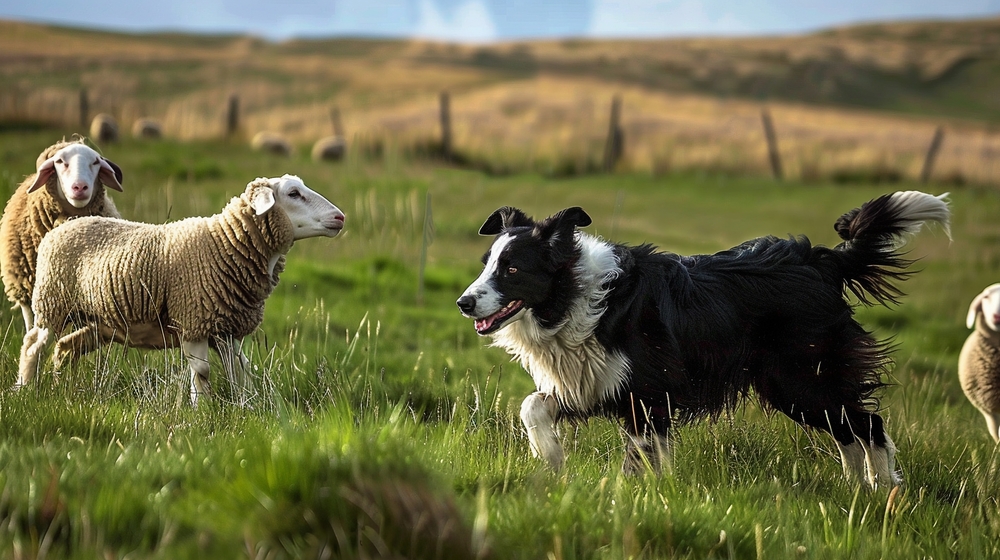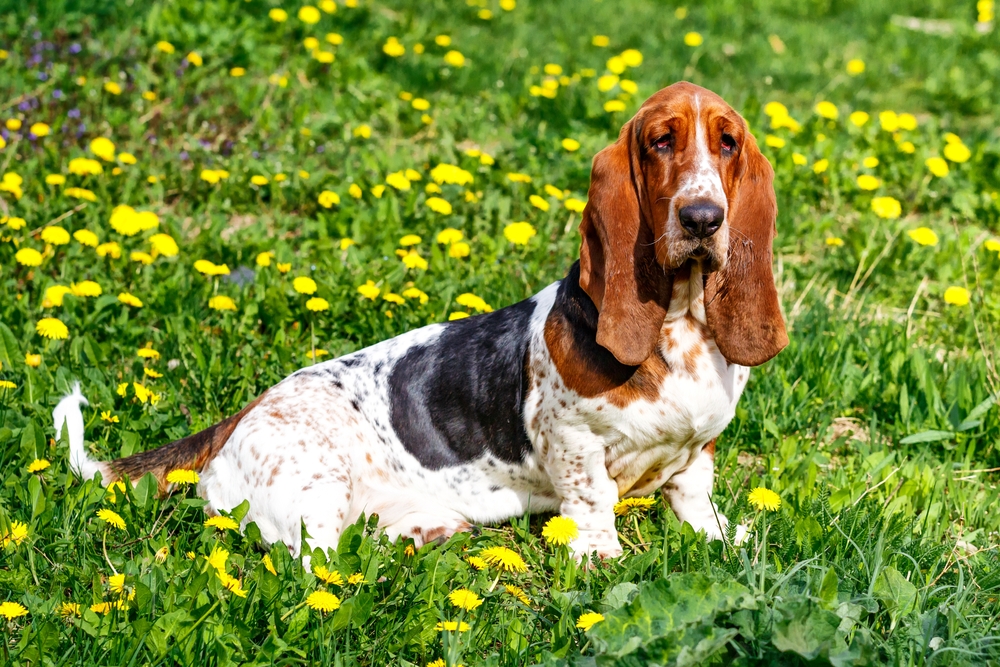The Border Collie’s closest relatives are other herding breeds from the British Isles, especially the Bearded Collie and Rough Collie. It also shares ancestry with various sheepdogs from the Anglo-Scottish border region, such as the Old Hemp line, which laid the foundation for modern Border Collies.
About
The Border Collie is widely regarded as one of the most intelligent and agile dog breeds, celebrated for its exceptional herding skills, boundless energy, and quick learning ability. Developed along the border regions of Scotland and England, the breed was specifically bred to manage livestock—especially sheep—through keen observation, swift movements, and intense focus. The Border Collie’s scientific name is Canis lupus familiaris, and it belongs to the family Canidae.
Border Collies are medium-sized, standing about 18–22 inches (46–56 cm) at the shoulder and weighing 30–55 pounds (14–25 kg). They have a well-proportioned, athletic build designed for stamina and speed, with a moderately long tail and expressive, alert eyes that convey intelligence and intensity. Their double coat can be either smooth or rough, and comes in a variety of colors, though black-and-white is most traditional.
One of the breed’s signature traits is its “herding eye”—a focused, almost hypnotic gaze used to control livestock movement. Border Collies are quick, agile, and capable of making sharp directional changes at high speed, making them exceptional competitors in dog sports like agility, obedience, flyball, and herding trials.
As companions, Border Collies are highly trainable but require considerable physical exercise and mental stimulation to remain happy and well-behaved. Without adequate outlets for their intelligence and energy, they may develop destructive or obsessive behaviors. They bond closely with their families, are generally good with children, and can be reserved with strangers.
The Border Collie thrives in active households, on working farms, or in homes committed to providing structured activities. With their unmatched work ethic, remarkable problem-solving skills, and eager-to-please nature, they remain one of the most versatile and capable dog breeds in the world.
Physical Characteristics
Border Collies are highly athletic, medium-sized herding dogs renowned for their agility, intelligence, and endurance:
Coat: They have a double coat that can be either smooth or medium-length and is weather-resistant. Coat colors vary widely, with black and white being the most common, but combinations may include red and white, tricolor, blue merle, red merle, sable, or solid colors.
Face: Border Collies have a moderately broad skull, well-defined stop, and a strong muzzle. Their eyes are oval-shaped and can be brown, blue, or one of each (heterochromia). Their alert, intelligent gaze is often referred to as the “herding eye,” used to control livestock. Ears can be erect, semi-erect, or tipped.
Body: They possess a balanced, lean, and muscular frame built for speed and agility. The chest is deep, the back is level, and the loins are strong, allowing for rapid acceleration and quick directional changes.
Tail: The tail is moderately long, set low, and carried with a gentle curve, especially when the dog is relaxed. It is well-feathered and aids in balance during movement.
Size:
-
Length (Body): Approximately 28 to 34 in (71 to 86 cm) from chest to rump.
-
Shoulder Height: 18 to 22 in (46 to 56 cm).
Weight:
-
Adult Female: 26 to 42 lbs (12 to 19 kg).
-
Adult Male: 30 to 45 lbs (14 to 20 kg).
Border Collies’ physical characteristics are designed for high-performance work. Their lean build, weather-resistant coat, and agile frame make them capable of sustained herding over long distances and challenging terrain, all while responding instantly to handler commands.
Reproduction
The reproductive cycle of Border Collies follows the general pattern of domestic dogs, with considerations for their working breed heritage:
1. Mating and Courtship:
Border Collies usually reach sexual maturity between 6 and 9 months, though responsible breeding typically waits until females are at least 18–24 months old to ensure full physical and mental maturity. Courtship often involves playful interaction, scent exchange, and social bonding behaviors.
2. Estrus Cycle:
Females typically come into heat twice a year, with each cycle lasting around 2–3 weeks. The peak fertility period is usually between days 9–14, but ovulation timing can vary among individuals.
3. Gestation:
The gestation period averages 63 days (about 9 weeks). Pregnant females benefit from a nutrient-rich diet, controlled exercise, and veterinary monitoring to ensure a healthy pregnancy.
4. Birth of Puppies:
Typical litter sizes range from 4 to 8 puppies, though litters of up to 10 are possible. Puppies are born blind, deaf, and completely dependent on their mother.
5. Care and Nurturing:
For the first 3–4 weeks, the mother provides warmth, protection, and nursing. Puppies begin opening their eyes around 10–14 days and start walking soon after.
6. Weaning and Socialization:
Weaning begins at about 4 weeks, with soft puppy food introduced gradually. Early socialization between 4–12 weeks is critical for Border Collies, as their intelligence and sensitivity require careful shaping to develop confident, well-adjusted adults.
7. Independence:
By 8–10 weeks, puppies are generally ready for rehoming. However, working-line Border Collie breeders may keep them longer for advanced early training and evaluation of herding instinct.
Because Border Collies are prone to certain inherited conditions—such as Collie Eye Anomaly (CEA), epilepsy, and hip dysplasia—responsible breeders perform genetic testing before mating to ensure healthy offspring.
Lifespan
Lifespan in the Home Environment:
Border Collies typically live 12 to 15 years, with some reaching 16 years or more when provided with excellent nutrition, mental stimulation, and veterinary care.
Lifespan in Working Roles:
Actively working Border Collies—used in herding, agility, and search-and-rescue—often maintain peak fitness longer but may face a slightly higher risk of injury. With proper care, many working dogs still live into their early to mid-teens.
Common Health Factors Affecting Lifespan:
-
Hip Dysplasia: Can lead to mobility issues in later years if not managed early.
-
Collie Eye Anomaly (CEA) & Progressive Retinal Atrophy (PRA): Genetic eye conditions that can cause vision loss.
-
Epilepsy: Some lines are prone to idiopathic epilepsy requiring lifelong management.
-
Osteochondritis Dissecans (OCD): A joint condition that may affect active young dogs.
-
Deafness: Occasionally present in merle-patterned Border Collies.
-
Overexertion: Their drive to work can lead to overheating or physical strain if not monitored.
Ways to Maximize Lifespan:
-
Provide a balanced, high-quality diet to support joint and heart health.
-
Ensure daily physical exercise and mental stimulation to prevent boredom-related stress.
-
Conduct regular veterinary checkups and genetic screenings for common breed issues.
-
Monitor for early signs of orthopedic or neurological problems.
With proper care, Border Collies often remain active, alert, and eager to work well into their senior years, retaining much of their agility and mental sharpness.
Eating Habits
Diet:
Border Collies require a nutrient-rich diet to support their high energy levels, whether working on farms or living as active companions. High-quality commercial kibble or raw/home-prepared diets (formulated under veterinary guidance) should include lean animal protein, healthy fats, complex carbohydrates, vitamins, and minerals. Protein sources like chicken, lamb, fish, and beef are ideal for maintaining muscle and stamina.
Feeding Schedule:
-
Puppies (under 6 months): 3–4 small meals per day to fuel rapid growth and constant activity.
-
Adults: 2 balanced meals per day to maintain steady energy levels throughout the day.
-
Working Dogs: May require increased portions or an extra small meal during periods of intense activity, such as herding or agility competitions.
Eating Behavior:
Border Collies are generally not gluttonous eaters compared to some breeds, but their caloric needs fluctuate based on activity level. Highly active individuals may burn through calories quickly, while less active dogs can gain weight if overfed.
Special Considerations:
-
Joint Support: Diets containing omega-3 fatty acids, glucosamine, and chondroitin can help protect joints over a lifetime of activity.
-
Brain Health: Omega-rich foods like fish oil can help maintain cognitive sharpness in senior years.
-
Energy Balance: Overfeeding sedentary Border Collies can lead to weight gain, which may stress their joints.
Treats and Extras:
Healthy treats like carrot sticks, apple slices (without seeds), blueberries, or small training treats can be given in moderation. For working dogs, high-protein snacks after long herding or agility sessions help replenish energy reserves.
A consistent, balanced diet matched to activity level is essential to keep Border Collies lean, energetic, and ready to work or play at peak performance.
Uniqueness
Border Collies are one of the most intelligent and versatile dog breeds, with traits that set them apart from all others:
Extraordinary Intelligence:
Widely regarded as the smartest of all dog breeds, Border Collies excel in problem-solving, obedience, and advanced training. They can learn hundreds of words, cues, and complex tasks.
Herding Eye:
Their intense, focused stare—known as the “herding eye”—is used to control and move livestock with minimal physical contact, a hallmark of their working style.
Unmatched Work Ethic:
Border Collies have an almost limitless drive to work, whether herding sheep, competing in agility, or performing search-and-rescue. They thrive when mentally and physically challenged.
Agility and Endurance:
With their lean, muscular build and quick reflexes, they can perform sharp turns, leaps, and sprints with ease, making them champions in dog sports.
Adaptability in Roles:
Beyond herding, Border Collies are employed in competitive obedience, canine freestyle, scent detection, and therapy work, demonstrating their versatility.
Strong Human Bond:
They are highly attuned to their handler’s voice, gestures, and emotions, forming exceptionally close working partnerships and family bonds.
Cultural Recognition:
Famed in sheepdog trials, films, and documentaries, Border Collies symbolize precision, discipline, and teamwork in the canine world.
Border Collies’ combination of high intelligence, intense focus, and athletic prowess makes them unmatched in the working dog category, but also means they require dedicated, active owners who can meet their mental and physical needs.
Be the First to Share Photos of This Species.
FAQ’s
1. What is the closest species to the Border Collie?
2. How does the Border Collie compare to other herding dogs?
Border Collies are generally more intense, agile, and intelligent than most herding breeds. While Australian Shepherds and German Shepherds excel in versatility, the Border Collie is unrivaled in precision herding and responsiveness to commands. They tend to have more stamina and a greater capacity for learning complex tasks, but also require more mental stimulation to prevent boredom-driven behaviors.
3. What national parks provide the best chances to see a Border Collie?
Border Collies are a domesticated working breed, so they are not found in the wild. However, they are commonly seen in dog-friendly parks and rural areas where herding is still practiced. Examples of national parks and public lands in the U.S. where leashed dogs are allowed and Border Collies may accompany their owners include:
-
Shenandoah National Park (Virginia) – Pet-friendly trails and campgrounds.
-
Cuyahoga Valley National Park (Ohio) – Popular with local hikers and their dogs.
-
Acadia National Park (Maine) – Many carriage roads and paths open to leashed dogs.
In sheep farming regions worldwide—such as the Scottish Highlands, Wales, and New Zealand—you’re also likely to encounter Border Collies working livestock near national park boundaries.





































































